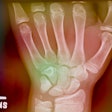
Black patients are more likely than other races to experience premature arteriovenous (AV) graft failure in the treatment of advanced kidney failure, according to a study published February 21 in Radiology.
Researchers led by Dr. Mikhail Higgins of Boston University analyzed data from a large group of patients who had hemodialysis vascular maintenance procedures at U.S. Veterans Health Administration (VHA) hospitals. Black patients had worse outcomes than any other patients, and the researchers called for an examination of factors that may lead to this inequity.
"As health care providers seek to reduce racial disparities, hemodialysis access for renal failure represents an important target for quality improvement," Higgins and colleagues wrote.
Hemodialysis is a treatment option for advanced kidney failure in which a machine outside the body filters a patient's blood. To aid with treatment, interventional radiologists create access to the bloodstream by installing either an AV fistula, catheter, or an AV graft, which is the placement of a flexible tube to create a path between an artery and a vein.
While AV fistulas are the preferred method for dialysis access, some patients may need to receive an AV graft when their veins are too small or weak for a fistula, the authors explained. These grafts can fail over time and require an immediate maintenance procedure.
Prior studies have found racial and ethnic disparities in the treatment of chronic kidney disease and access to dialysis, and in this retrospective study, the researchers aimed to further identify racial disparities among premature AV graft failures.
The group analyzed data from 1,950 hemodialysis vascular maintenance procedures in 995 patients at 61 VHA hospitals between October 2016 and March 2020. Most procedures involved Black patients (1,169, 60%) and patients residing in the South (1,002, 51%). Premature access failure occurred in 215 of 1,950 (11%) procedures.
When compared with all other races, Black race was associated with premature access site failure (prevalence ratio, 1.4; p = 0.02). However, among the 1,057 procedures in 30 facilities with interventional radiology resident training programs, there was no evidence of racial disparity in the outcome (prevalence ratio, 1.1; p = 0.63), according to the findings.
"Our findings are similar to those of other studies showing that African American patients have higher adverse event rates related to provider behaviors, including perioperative errors," the researchers wrote.
Although the results suggest that there are environmental and cultural characteristics of teaching sites that may help to reduce racial disparities in patient care and health outcomes, the researchers stressed that the association between facilities with teaching programs and health outcomes should be further studied.
"We cannot say that patients should find hospitals with teaching programs, as our results do not show this direct relationship," said senior author Dr. Hillary Mull, in a news release from RSNA.
Ultimately, future studies should investigate the occurrence of graft failures in non-VHA populations as well as other factors, such as provider, facility, and regional practices, that can reduce these racial disparities in premature graft failure, the authors concluded.



















